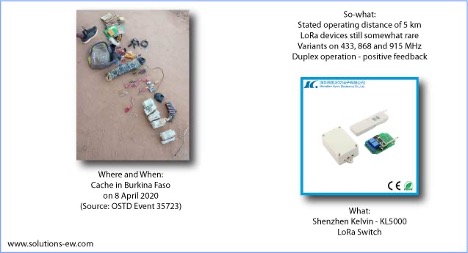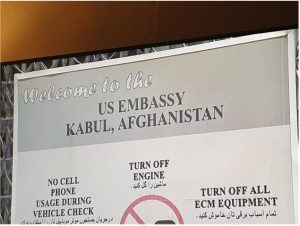Where CEMA and Multi-Domain integration meets the improvised threat


Troy Phillips, Business Development Director at EWS
Troy Phillips, Business Development Director for EWS discusses why a coherent CEMA strategy and Multi-Domain Integration are a necessity for mitigating current and emerging threats.
Background
Dave Ruddock, the CTO at EWS recently wrote a blog about the evolving technical landscape and how the fast-paced ongoing technical revolution provides both the operational community and industry with many challenges. These challenges are of particular interest when they provide technical innovation for the development of improvised threats. Of course, they also provide industry with the opportunity to deliver thought leadership and innovation in order to protect and enable those who conduct operations and need the ability to manoeuvre. Increasingly, manoeuvre will be directly linked to information dominance.
There is no doubt that the range of technology available to those who wish to commit acts of terrorism has never been better. If you are a terrorist, technology like the Internet of Things (IoT) in particular is great at creating a myriad of perfect switches designed for commercial use but also perfectly suited to use in improvised threats, such as IEDs and drones. Those of a younger generation than me expect a fully enabled life and routinely gadgets that achieve this are becoming an integral part of our life – only last week I saw a Zigbee for sale in Aldi – how did that happen?
The roll out of 5G, 6G, WiFi 6 etc. etc. just assists with the functionality and usability of these switches and adds to the challenge faced by those of us who spend our life trying to defeat or mitigate threats. The switches are supported by ever better networks, data rates and connectability.

IoT Devices in Burkina Faso, 2020 [1]
CYBER ELECTROMAGNETIC ACTIVITIES DEFINED 1-1. Cyber electromagnetic activities are activities leveraged to seize, retain, and exploit an advantage over adversaries and enemies in both cyberspace and the electromagnetic spectrum, while simultaneously denying and degrading adversary and enemy use of the same and protecting the mission command system.
It’s important not get wrapped up in doctrine and terminology as they change from country to country and continually evolve. From the top level, EW, EA, ECM, CEMA may mean many things to many people so I’d rather look holistically, not by definitions.
It is however a strange thing, CEMA. To many, it seems like something that is coming some-time in the future, but in reality, CEMA operations have been conducted against improvised threats for decades. Admittedly, the Cyber aspects in this role are relatively new and continually developing but controlling while concurrently protecting our interests in the electromagnetic battlespace and environment are genuinely run of the mill.
 On watching the news last night (18 August 2021), one realises how mainstream the capability is when the reporter was outside the abandoned US embassy in Kabul stood next to a big sign that stated “Turn Off all ECM Equipment [2] ”.
On watching the news last night (18 August 2021), one realises how mainstream the capability is when the reporter was outside the abandoned US embassy in Kabul stood next to a big sign that stated “Turn Off all ECM Equipment [2] ”.
Historical context
‘Traditional’ ECM has been very much based on ‘the power battle’. Basically, whoever gets more power into the receiver wins. If the bad guy wins, the device functions, if the good guy wins, it’s held in a temporary state of safety. The methodology has been going on since the 1970’s and although the threat picture has changed and technology has moved on, the principle has remained constant. One thing that has also remained constant is the fact that if you are a terrorist or insurgent, if you want to engage a mobile target, the radio-initiated device (RCIED) continues to be the primary option. Most switches for the devices are commercial off the shelf (COTS) and the threat is predictable – in principle the bad guys will use the most effective, easy to use device until the good guys stop them by using a combination of tactics and technology at which point the threat migrates.
This migration could be tactically or by changing the make-up or frequency of the device. It really is a cat and mouse game and has traditionally involved (in practice) reprogramming ECM. Sometimes, the ECM system cannot take on any more responsibility for extra bandwidth or capacity so extra equipment needs to be added to ‘the fleet’. This extra capacity is somewhat achievable with vehicle borne systems, but provides a real challenge to dismounted ECM users who already have to carry more than they are designed to!
Why CEMA and why now?
Here’s where the reality of operations, the advancement of COTs equipment and CEMA collide. The ability to defeat those self-healing, low powered, smart and extremely programmable devices will make some threats very hard to kill using traditional systems, tactics and processes. The more power we try and use, the more interoperability problems we create and we live in a continually evolving ‘enabled’ operational space. We have to be cleaner and smarter with our effects in order to create an environment that facilitates freedom of manoeuvre and action.
We’ve come to a crossroads whereby the RF enabled threat posed by both asymmetric and near-peer adversaries demand a new way forward. CEMA is that platform; a CEMA that is delivered by any suitable asset or mainstream digital backbone, available in the midst of multi-domain operations. We have to be much smarter to out-gun the technology. We have to focus our efforts on the development of smart techniques and move away from using brute-force RF systems.
Industry and the eco system; and the reality of maintaining operational readiness
 ECM capability is best funded, developed and maintained during periods of conflict. Between conflicts there are always challenges for industry in rationalising the investment needed to keep at the cutting edge of technology if there are no funded programmes. Even with the emphasis on new approaches (CEMA) identified in the UK Government’s Integrated Review 2021 [3], industry still has genuine challenges to continue to develop systems that are capable of rapidly deploying and responding to new technical threats without a clear funding stream or route to market.
ECM capability is best funded, developed and maintained during periods of conflict. Between conflicts there are always challenges for industry in rationalising the investment needed to keep at the cutting edge of technology if there are no funded programmes. Even with the emphasis on new approaches (CEMA) identified in the UK Government’s Integrated Review 2021 [3], industry still has genuine challenges to continue to develop systems that are capable of rapidly deploying and responding to new technical threats without a clear funding stream or route to market.
The key to the success is a new approach to CEMA and ECM capability; an approach where industry has a key part to play. Systems developed must be flexible and have architectures that allow minimal changes to hardware and can deliver CEMA effect from software defined radios, specialist techniques and innovative applications but must be commercially viable and suitable for export to a global marketplace.
These challenges mean that there must be closer collaboration and partnerships between industry and authorities and an eco-system that involves both ‘traditional’ suppliers but also embraces small and medium enterprises, academia and the science and technology community. The eco-system will need to be agile and proactive with a view to having software, techniques and applications ‘ready to go’ and be available in whatever capacity the ‘CEMA Toolbox’ takes. For the operational community, hardware changes need to be a last resort.
At last!
The team at EWS are a broad cross-section of practitioners with a wealth of both operational and industry expertise in the EW and CEMA domains. As the rapid development of CEMA equipment, tactics, techniques and procedures gather pace we’re able to provide experience-based guidance in support of pan-domain activities.
Out of necessity, I genuinely think we’ve come to the stage where when deploying on operations, our CEMA assets will be loaded onto ships and airframes before our armour and artillery systems; something the EW community has been trying to achieve for the whole of our careers. I have no doubt there are some gunners, airborne forces, infantry and cavalry who may wish to debate that with me for a while yet though! 😊
— — — — —
About the Author
Troy Phillips is the Business Development Director for EWS and he has been involved in RF spectrum operations for almost 40 years. Initially as a British Army High Threat EOD ECM operator, Warrant Officer, and Electronic Warfare Operations Officer. During his second career in industry since 2005, Troy has been involved with many global counter terrorism related activities and in particular the defeat of the RCIED including the establishment of EW Solutions Ltd with his partners in 2009. Key achievements have been supporting such esteemed organisations as the FBI, the USMC, the UK MoD and UK counter terrorism policing, as well as many other entities globally. Troy is currently the ECM Advisor to the Executive Committee of the UK Industry’s Counter Explosive Ordnance group (C-EO UK) and concurrently is delivering a related Master’s Level course for Oklahoma State University. EWS continues to provide intelligence-led support to operations globally.
References and sources:
[1] LoRa photo courtesy © les Forces de Défense et de Sécurité, Burkina Faso. The stock photo of the product next to it is ©Shenzhen Kelvin Electronics Company Limited.
[2] Photograph courtesy of ITV News at 10, 18th August 2021




